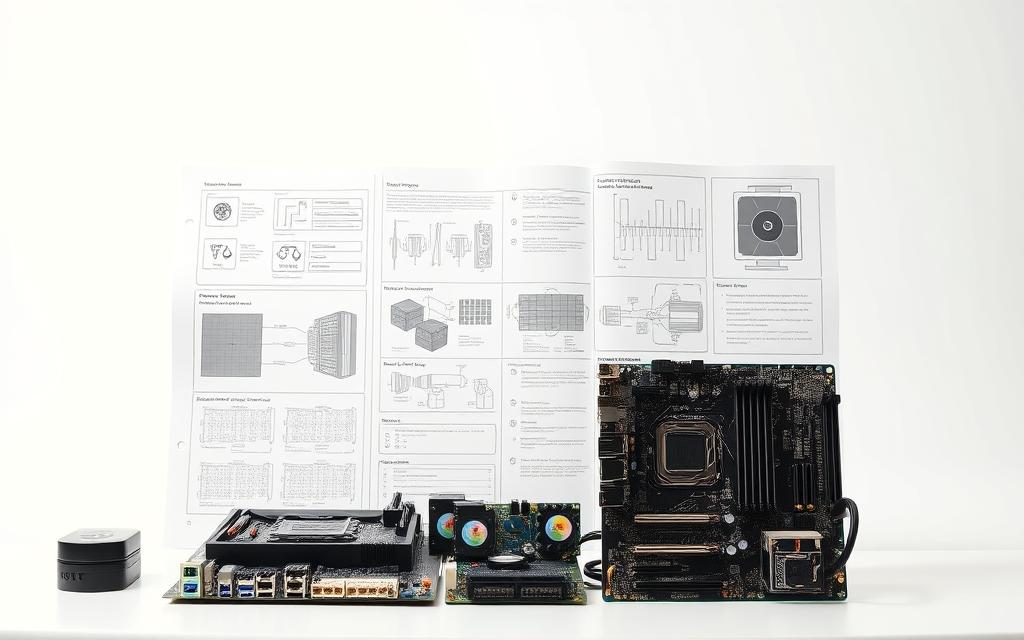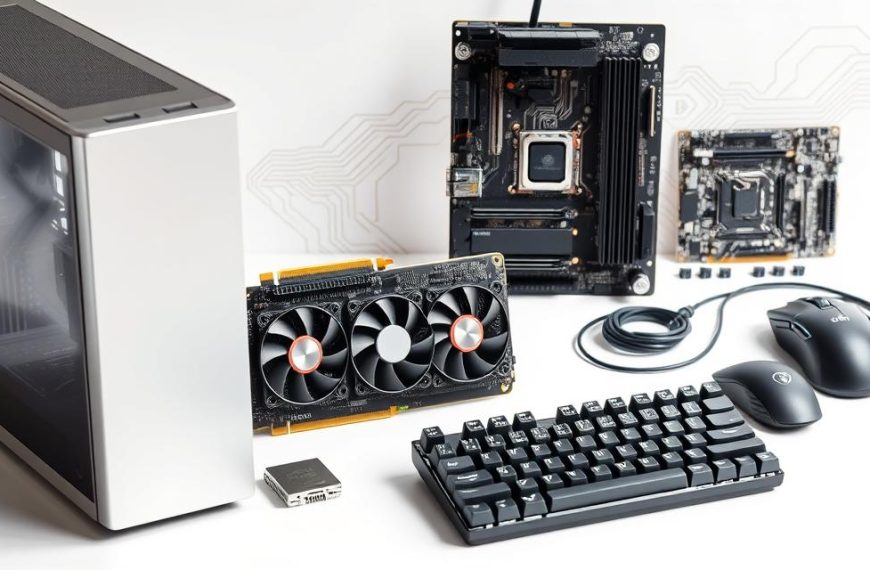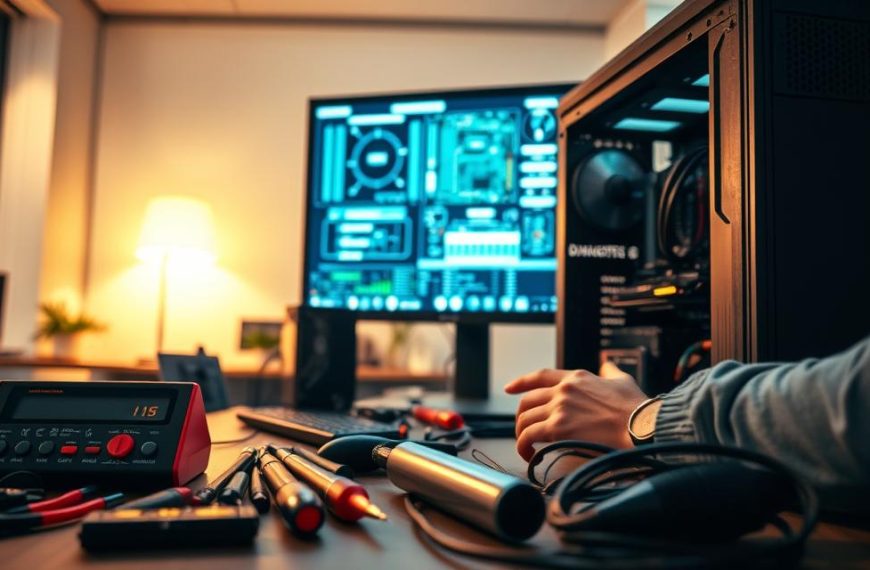Computer hardware troubleshooting is vital for fixing PC problems that affect system performance. About 70% of computer issues stem from hardware failures. Understanding diagnostic techniques is crucial for resolving these problems efficiently.
Hardware challenges are common for modern computer users. System crashes and freezes make up 30% of hardware issues. Slow performance accounts for 25% of reported problems.
Identifying PC problems requires a methodical approach. Common issues include overheating components, strange noises, and unexpected error messages. Understanding these problems can prevent costly repairs.
This guide covers essential troubleshooting techniques to help you diagnose and fix hardware problems. You’ll learn about checking power connections and using diagnostic tools. These skills will help you tackle most computer hardware challenges.
IT technicians typically spend 30 minutes fixing a single hardware issue. By using a structured method, you can cut diagnostic time. This approach helps restore your system’s performance quickly.
Essential Preparation Before Hardware Troubleshooting
Proper preparation is key to successful hardware troubleshooting. It saves time and prevents damage to computer systems. Careful planning can resolve many issues before complex diagnostics begin.
Safety precautions are vital when handling electronic components. Simple connection checks can solve up to 50% of computer problems. These preliminary steps are crucial for effective troubleshooting.
Safety Precautions and Essential Tools
A strategic approach is necessary for hardware troubleshooting preparation. Safety measures are critical for protecting both you and the equipment.
- Disconnecting power sources before inspection
- Using anti-static wrist straps
- Working in a clean, well-lit environment
- Wearing protective gear like safety glasses
Having the right tools is crucial for effective hardware troubleshooting. Here’s a list of essential items:
- Precision screwdriver set
- Anti-static mat
- Thermal paste
- Compressed air canister
- Multimeter
Creating System Backup
Many users only realise the importance of data backup after a critical hardware failure. Always create a comprehensive system backup before starting any troubleshooting process. This protects your valuable information from potential loss.
Documenting Current System State
Proper documentation is crucial for effective troubleshooting. Organisations without it can face up to 50% more downtime. Record detailed system information to aid in problem-solving.
- Hardware configuration
- Current software versions
- Recent system changes
- Error logs and diagnostic reports
Preparation transforms potential hardware disasters into manageable challenges.
When Troubleshooting a Computer Hardware Problem
Hardware problem diagnosis needs a step-by-step approach to fix computer issues. Users can use smart methods to find and solve hardware problems.
Successful hardware problem diagnosis involves key steps:
- Identify specific system symptoms
- Categorise performance anomalies
- Isolate potential hardware components
- Test individual system elements
About 70% of hardware issues come from loose or faulty connections. This shows why careful checks are vital. Regular upkeep can greatly reduce possible problems.
Patience and methodical investigation are key to resolving complex hardware difficulties.
Users should think about these vital troubleshooting steps:
- Restart the system – Fixes about 30% of common issues
- Run comprehensive diagnostic tools
- Check physical connections
- Update device drivers
- Verify power supply stability
Using a planned approach to hardware problem diagnosis helps users tackle tech issues. It also keeps computers running at their best.
Advanced Diagnostic Techniques for Hardware Components
Computer hardware diagnostics need a step-by-step approach to solve complex tech issues. Testing components helps spot problems before they become major system failures.
Modern computers need precise diagnostic methods to work well. Special tools can cut troubleshooting time and stop hardware breakdowns.
Memory and RAM Diagnostic Strategies
RAM testing is vital for system stability. Experts suggest these methods for thorough hardware checks:
- Use MemTest86+ to check RAM integrity
- Run Windows Memory Diagnostic tool
- Check for memory module compatibility
- Verify RAM timings and voltage settings
CPU and Motherboard Problem Detection
Finding CPU and motherboard issues needs advanced techniques. Key strategies include:
- Monitor system temperatures using HWiNFO
- Check for firmware and BIOS updates
- Inspect physical damage and connections
- Use benchmarking tools to assess performance
Graphics Card and Display Troubleshooting
Graphics hardware checks involve these critical steps:
- Update graphics drivers regularly
- Run stress tests with 3DMark
- Check display connection integrity
- Monitor GPU temperature ranges
Storage Device Assessment
Storage device health is crucial for keeping data safe. Try these testing methods:
- Use CrystalDiskInfo for SMART analysis
- Check read/write speeds
- Verify disk partition integrity
- Monitor reallocated sector counts
Using these advanced hardware checks helps find and fix system issues early. This ensures your computer stays reliable and performs well long-term.
Resolving Common Hardware Malfunctions
Computer users often struggle with common hardware issues. A systematic approach is crucial for diagnosing and fixing technical problems effectively.
Power supply failures are a major hardware challenge. About 30% of laptop users face battery problems that stop their devices from starting.
These issues can arise from faulty adapters, worn-out batteries, loose connections, or damaged power units.
- Faulty power adapters
- Degraded battery cells
- Loose power connections
- Internal power supply unit damage
Overheating is another common issue affecting computer performance. Nearly 15% of users experience system slowdowns due to inadequate cooling.
To fix this, try cleaning internal parts, improving ventilation, and replacing thermal paste. Also, check if the fans are working properly.
- Cleaning dust from internal components
- Ensuring proper ventilation
- Replacing thermal paste on CPU
- Checking fan functionality
Hard drive problems can greatly impact system reliability. About 10% of users report strange noises that might mean the drive is failing.
To address storage issues, run diagnostic tests and back up important data right away. Check for bad sectors and think about replacing the drive.
- Running diagnostic software
- Backing up critical data immediately
- Checking for bad sectors
- Considering drive replacement
Peripheral device failures also cause significant problems. Around 15% of users face connectivity issues, often fixed by updating drivers or replacing cables.
Professional diagnostics can resolve approximately 80% of hardware-related issues when approached systematically.
Regular maintenance and understanding these hardware issues can greatly improve your computer’s lifespan and performance. Stay informed to keep your system running smoothly.
When to Seek Professional Help
Computer hardware issues can be tricky to diagnose. Many users try DIY repairs, but some problems need expert help. Knowing when to call a pro can save time and protect your device.
Professional intervention is vital for complex hardware issues. These often require special tools and knowledge beyond most users’ skills.
- Persistent blue screen errors
- Unexplained system crashes
- Strange mechanical noises from hard drives
- Overheating components
- Unidentified electrical problems
About 60% of tech support issues are hardware-related. Professional computer repair services can diagnose and resolve these complex problems with up to 90% accuracy. DIY repairs might make things worse.
Don’t risk permanent damage – professional help is often the most cost-effective solution.
Choose repair services wisely. Look at their credentials, experience, and customer reviews. Seek technicians with recognised certifications and a solid track record.
Regular maintenance can prevent most hardware issues. Professional diagnostics can extend your computer’s life and keep it running smoothly.
Conclusion
Computer hardware issues need a systematic approach. Most problems come from manageable technical challenges. About 70% of performance issues link to software and hardware interactions.
PC maintenance tips are vital to prevent system failures. Regular checks can reduce the risk of critical hardware breakdowns. Tools like Windows Memory Diagnostic help spot potential issues early.
Effective hardware troubleshooting isn’t just about fixing current problems. It’s also about creating a preventative strategy. Regular maintenance and using diagnostic tools can extend your computer’s life.
Power cycling and proper care ensure optimal performance. These steps turn technical challenges into manageable tasks. With patience and method, you can handle your computer’s health confidently.
Every computer user can become skilled in hardware maintenance. The right knowledge and tools are key. Stay informed and you’ll master your computer’s performance.









